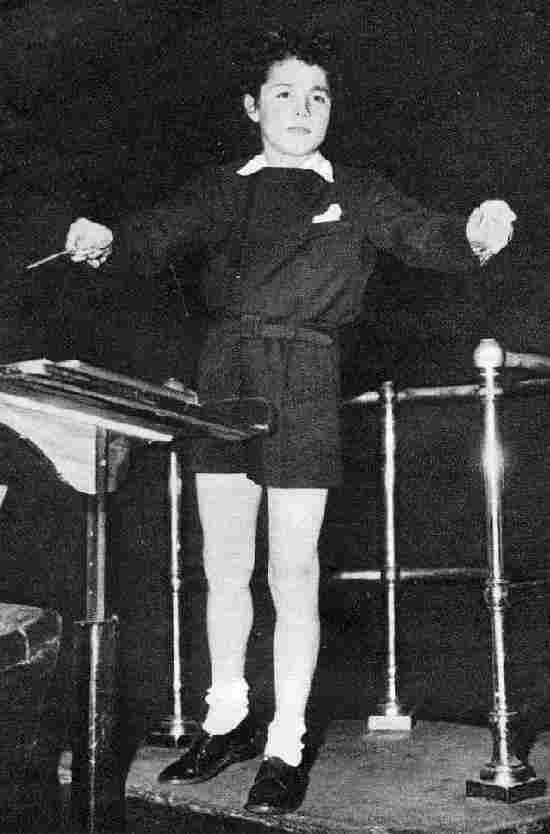
Figure 1.--Roberto Benzi was a popular child prodigy in the 1950s who also appeared in movies. He wears a specially made shortpants outfit with a curious collar arrangement. He also had white outfits.

One of the best source of information on prodigies is Musical Prodigies: Perilous Journeys, Remarkable Lives by Claude Kenneson. Besides this important book there are several valuable works on the experience of prodigies as well as individual prodigies.
Benjamin Bloom in Developing Talent in Young People (Ballantine Books, 1985) emphasizes the role of music education during the child's formative years.
Hellen Epstein's Music Talks (McGraw-Hill, 1987) emphasizes the role of music education during the child's formative years. Bloom's book (based on psychological studies and interviews) has several chapters on the
lengthy and arduous music education of concert pianists. Epstein has interviews with many outstanding musicians such as Itzhak Perlman, Cho-Liang Lin, Midori and Yo-Yo Ma. She
also describes the work of the violin teacher Dorothy DeLay (Juilliard School of Music) with violin prodigies.
David Feldman's Nature's Gambit: Child Prodigies and the Development of Human Potential (Basic Books, 1986) discusses the psychological research concerned with the development of intellectual precocity. Many sections of this book concentrate on musical prodigies.
Perhaps the best source of information on prodigies is Claude Kenneson's Musical Prodigies: Perilous Journeys, Remarkable Lives (Amadeus Press: Portland, Oregon, 1998). Van Cliburn even wrote a forward. The author explores early family life, first teachers, the importance of peers, and the inevitable struggles for independence and acceptance as an adult musician. For some, the promise of childhood was borne out, the difficult passage through adolescence successfully weathered. For others, fate dealt a different hand. In a fascinating conclusion to the volume, Bejun Mehta offers an insider's view. His is the remarkable story of a celebrated boy soprano who struggled to find his muse again after his voice changed. His insights illuminate many wondrous elements of the prodigy's experience. Parents and families of gifted children in all the arts will welcome these insights into the many wondrous elements of the prodigy's experience. This is a celebration of the remarkable lives of 44 musical prodigies from the 18th century to the present, including the amazing stories of Mozart and Paganini, Andrés Segovia and Samuel Barber, Van Cliburn and Ruggiero Ricci, Shauna Rolston and Yo-Yo Ma, to name only a few.
Carson McCullers short story "Wunderkind: Reflections In A Golden Eye" and other stories is a very touching and sad story of a child prodigy (a girl violinist) whose career is over as she enters adolescence.
Peter F. Ostwald's Glenn Gould: The Ecstasy and Tragedy of Genius (W.W. Norton & Co.: 1997) provides a fascinationg look at the canadian prodigy. This highly eccentric pianist and expert on Bach clearly exhibited many positive and negative characteristics of his personality and musical accomplishment. Ostwald describes these characteristics in detail from Gould's early life as a musical prodigy to his later tragic years as a neurotic, isolated individual who suffered from severe hypochondria.
Issac Sterns autobiographical Isaac Stern: My First 79 Years (Knopf, 1999) was written with Chaim Potok. Here is the extraordinary life and professional career of this joyous, world-renowned musician. Stern's family immigrated from Russia to San Francisco where he began his accelerated progress and success on the violin starting at about 8 years.
Another survey of the child prodigy experience is Ellen Winner's Gifted Children: Myths and Realities, (Basic Books, 1966). The author provides detailed descriptions of children who have exceptional musical abilities, and she makes insightful statements about the nature of musical giftedness. She tells the story of one child who began playing the electric guitar at 8 years. Another child began sight reading at age 5 and liked music theory and notation. He began composing music at seven years.
Navigate the Historic Boys' Clothing Web Site:
[Return to the Main prodigy experience page]
[Return to the Main prodigy page]
[Introduction]
[Activities]
[Bibliographies]
[Biographies]
[Chronology]
[Clothing styles]
[Contributions]
[Boys' Clothing Home]
Related Chronolgy Pages in the Boys' Historical Web Site
[Main Chronology Page]
[The 1860s]
[The 1870s]
[The 1880s]
[The 1890s]
[The 1900s]
[The 1910s]
[The 1920s]
[The 1930s]
[The 1940s]
[The 1950s]
[The 1960s]
Navigate the Historic Boys' Clothing Web style pages:
[Kilts]
[Caps]
[Sailor suits]
[Sailor hats]
[School uniform]
[Scout]
